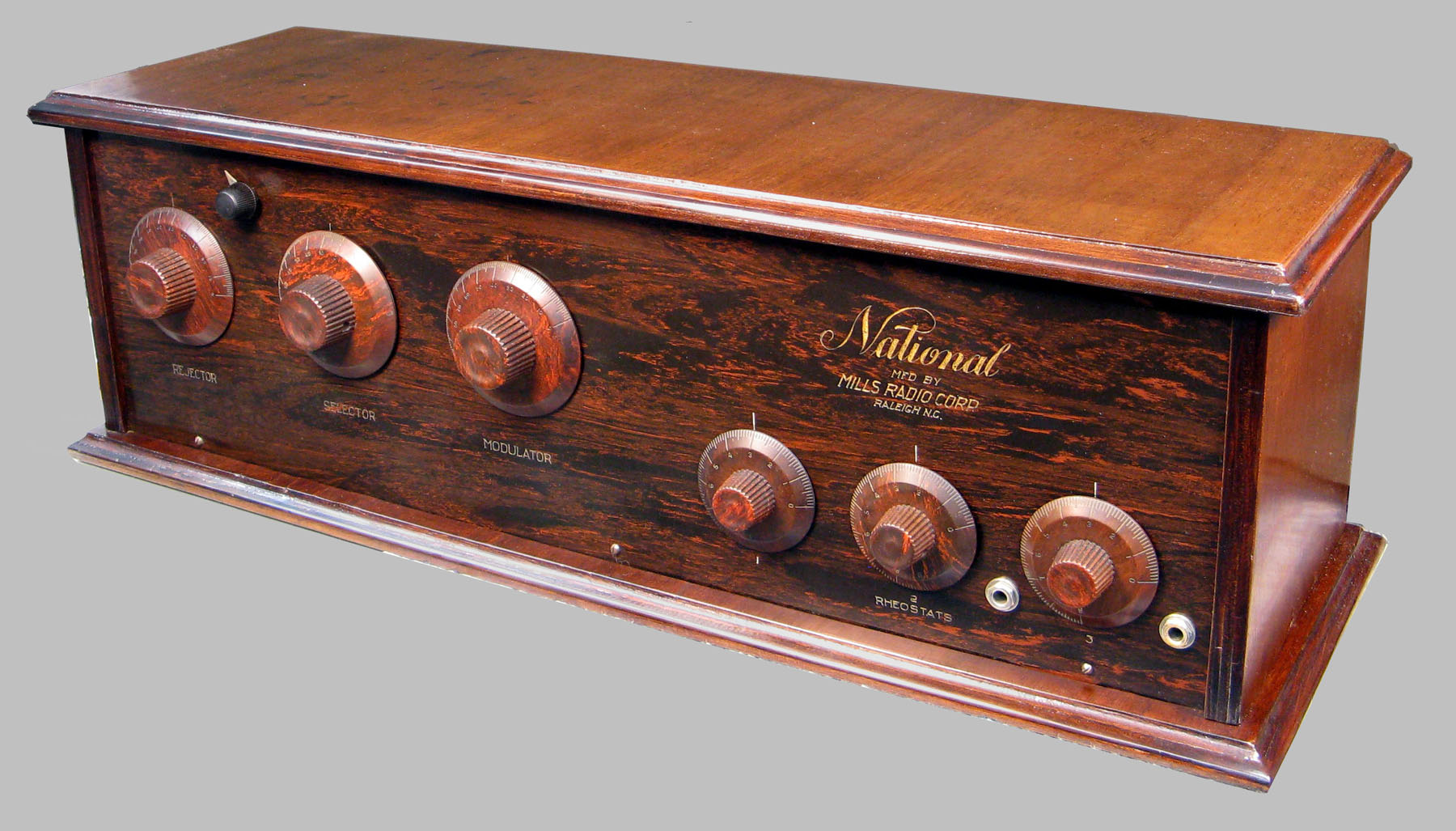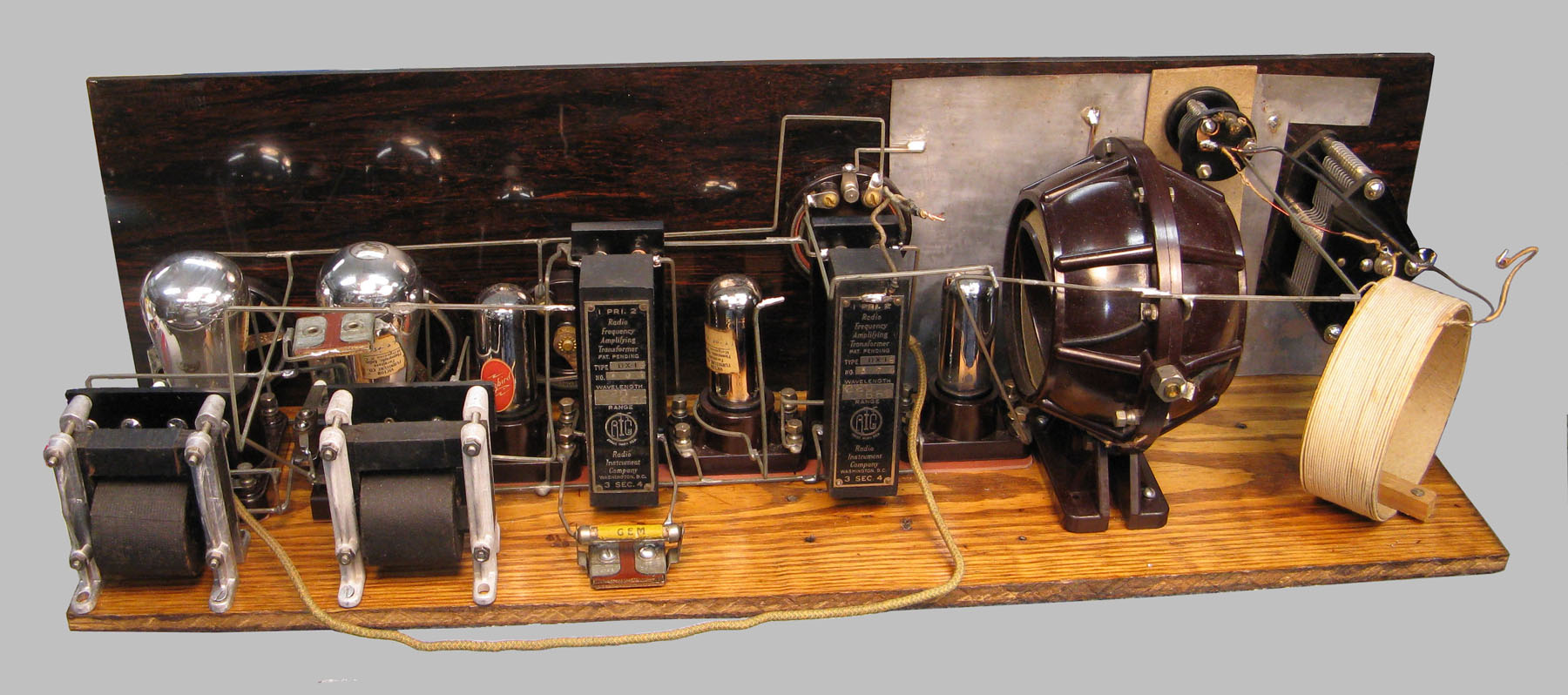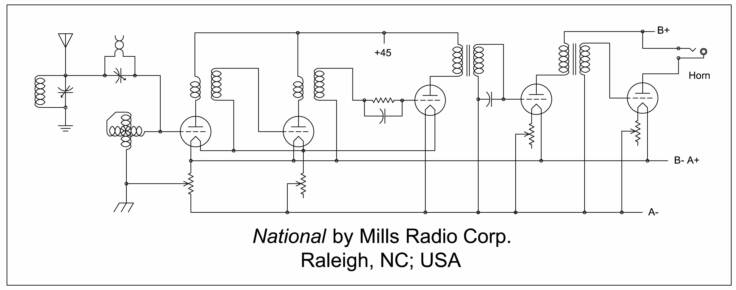NATIONAL by Mills Radio Corporation
Raleigh, NC – Circa 1923-24

This Mills Radio Corp., Raleigh, NC outfit must date from late 1923 into maybe 1924. It seems to be only the fifth known surviving, branded, 'made in NC' broadcast band radio of the 1920s. It was found by a picker at a yard sale in Wilmington, NC in October 2019. He could offer no background on the set. A search of microfilmed Raleigh newspapers seems to indicate that, at that time, the newspapers must have been deliberately boycotting any news of the radio broadcast industry or taking any advertising mentioning radios for sale.... Regarding them as competition. The largest city paper of the 1920s, The News & Observer, is well documented to have been heavily associated with the forces of white supremacy so maybe they also had no desire to have broadcasting importing 'outside ideas'. This is distinctly the opposite position exhibited by owners of the Asheville, NC Citizen newspaper. In 1922, on the third floor of the Citizen building, rooms were let to a Mr. Rambau who was building radios sold under the brand of Hi-Grade Wireless Apparatus, Co. and obtained a license to operate a tiny broadcast station, WFAJ. The Citizen had numbers of radio articles and small advertisements for radio parts and sales from 1922 onward.
The only information I've found on the Mills Radio Corporation is a listing in a 1924 Raleigh City Directory giving the business location and the names of three principal officers. This was in the holdings of the N. C. State Archives. There is a City of Raleigh Museum (COR) but, so far, I have not received any responses to my e-mail queries about this business. I have not been in a position to travel to the museum.
I went to my local library where you can access ancestry.com and newspapers.com. A half hour of searching provided no hits, but must admit I am a complete novice at genealogy research.

Circuit description……
For now, all I can say is that this set is a 'non-infringing' design, (i.e. No regeneration.) incorporating two plug-in broad band RF transformers made by the Radio Instrument Co., Washington, DC. An antenna connected to a parallel tuned circuit with signal capacitively coupled to a variometer. From the high side of the variometer the signal is connected to the grid of the first UV-199. The plate of this tube drives a broad band RF transformer feeding the grid of the second UV-199. The plate of this second tube drives a second RF transformer coupled to the grid leak detector tube. The audio signal is now coupled to a standard audio transformer for amplification via two-stages using UV-201A tubes. It is unusual to see a mix of UV-199 tubes and UV-201A tubes in a receiver. The three parallel connected filaments of the UV-199 tubes are controlled by a single rheostat in series with the 6 Volt storage battery connections. To avoid applying over voltage to the tubes, the rheostat has been modified with a band of iron wire wrapped around the resistance element forming a bump that blocks complete rotation of the rheostat wiper towards zero Ohms. I don’t think I have seen such a modification before.
There is a 50pf. variable capacitor obviously kluged into place on the panel. Note that a ‘gimick’ capacitor is in parallel with this part. The severe lack of selectivity in this design would have destroyed its market value by mid-1924 when the Department of Commerce started allocating more broadcast channels. Three of the tubes carry paper stickers dated late 1927 from a shop in Morganton, NC. So, it seems as if this radio was in use for at least three years. If all you wanted to do was hear a local station in the daytime, I guess this set would still have some utility.
The hard rubber panel is made by Radion and extruded with chips of various brown and red to suggest a colorful mahogany style look and, no doubt, they were the ones that would engrave whatever you wanted on the panel for a fee. The knobs are also made of multi-colored hard rubber.
The cabinet seems to have been made at a local cabinet shop. Kind-of odd in having the veneers on the top lid and the base of the cabinet oriented along the narrow dimension. There was lots of veneer delamination to repair on the top and base. Half the bottom board veneer was missing. The chassis is yellow pine; a common wood for North Carolina.
I find it curious that the tube sockets and RF transformers are isolated from the pine board by a 1/16” thick sheet of red, rubber gasket material. This material is not necessary for insulation and it is not anywhere near thick enough to provide even minimal microphonic isolation or to compensate for shrinkage of the pine board. The only effect it had in the long run is to provide a source of Sulphur that heavily corroded the phosphor bronze tube socket contacts. Fortunately, while heavy, persistent cleaning in the ultrasonic cleaner removed virtually all the oxidation.
The battery connections on the back of the cabinet have no identification except for hand embossed script into the wood veneer. The way the terminals are wired-in, it leaves one to think that not enough thought was put into ease of assembly for the layout.
Was this radio a “trial balloon” that never made it off the ground? Did they contract with Radion to make more than one panel? Were they hampered by the apparent fact that they could not advertise in their local newspapers? Hopefully some history of the Mills family will turn-up.
Raw info.
The 1924 Raleigh City Directory is the only print reference I have been able to find. It lists: Mills Radio Corp. 109 E. Davie - Daniel Mills - v-p & gen manager - h 211 N Blount., Mills John M, pres Mills Radio Corp h 317 S Boylan Av, Mills Walter H (Mills Tire Co), sec-treas Mills Radio Corp h 418 S Boyland Av.
From the collection of:
Robert Lozier – KD4HSH
Monroe, NC; USA
Kd4hsh@carolina.rr.com

For more info click on this icon.
